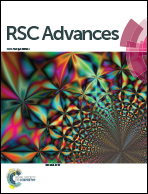Generation of controlled monodisperse porous polymer particles by dipped inkjet injection†
Abstract
A straightforward approach for the preparation of monodisperse porous polymer particles by inkjet technology is reported. Uniform droplets of an aqueous polymer solution were ejected from an inkjet, the nozzle of which was immersed in an organic phase. The subsequent dehydration of the droplets by solvent extraction resulted in the formation of porous polymer microspheres. Particles with a narrow size distribution could be obtained using the present system in a single step. Parameters for polymer droplet generation in an organic phase, including polymer properties, organic solvent, and inkjet waveform, were investigated. The relationship between the final particle diameter and the initial polymer droplet size were also examined. The diameters of the particles could be precisely controlled by changing the waveform exerted on the inkjet, thus producing particles with diameters in the range of 15 μm–60 μm with a coefficient of variation (CV) in the range of 2.7–4.8%. It was also possible to produce hollow porous polymer particles by simply decreasing the concentration of the polymer solution. The results demonstrate the merit of the inkjet-based method for the generation of monodisperse porous polymer particles. The method has the potential for producing functional polymer particles via the incorporation of functional or smart materials.


 Please wait while we load your content...
Please wait while we load your content...